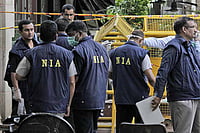Atleast four Bedouin Arabs of the Israel Army have been killed in the ongoing Israel-Palestine war and several of them have been taken as hostages by the Hamas militant group following the attack on October 7. While purported social media video shows local Israelis expressing gratitude to a Bedouin commander named Ashraf for putting up an effective defence against Hamas fighters, the Hamas attack has also cast a heavy toll on the Bedouin Arabs living in the Negev desert of southern Israel.
Following the Hamas attack, the mayor of the predominantly Arab Bedouin city of Rahat, Israel, said that 19 Bedouins had been killed in the assault by Gaza militants and urged the government not to forget that his community were victims of the attack. Recently, the Washington Post quoted Ata Abu Mediam who said that many have been wounded, injured and taken to Gaza. “We are suffering. We do not have shelters," he said, adding that Israel has abandoned the Bedouin Arabs for long.
Who are Bedouin Arabs?
The Bedouin Arabs are a nomadic tribe in Israel and are indigenous people of the Negev desert. They mainly identify as Palestinian Arabs but use the term Bedouin to refer to their nomadic way of life.
According to UNHCR, 92,000 Bedouins were estimated to be living in the Negev in 1947. But out of them, only 11,000 remained after the foundation of Israel and the others were never fully accounted for. Those who remained were treated particularly harshly, uprooted time and again and forced to live in reservations (resettlements?). Currently, there are around 200,000 Bedouins in Israel, including some 80,000-90,000 living in 35 'unrecognized villages' at constant threat of eviction or forced displacement by authorities.
Displacement of Bedouin
After the formation of Israel in 1948, thousands of Bedouins, who owned land under a clearly defined traditional system of individual and communal land ownership, were displaced and forced to find resettlement into a smaller territory in the Negev known as the 'Siyag', meaning 'the fence' in Arabic.
During and immediately after the 1948 war that followed Israel's declaration of independence, most Bedouins were expelled or fled their homes and moved to Jordan, Syria, the West Bank and Gaza. As a result, the Bedouin population in the Negev shrank from 92,000 to 11,000, representing just 19 of the original 95 tribes that lived in the area.
Between 1948 and 1966, the Israeli government created several land laws including the 1953 Land Acquisition Law that uprooted Bedouins from their ancestral lands and gave the government the authority to resume (reclaim?) the lands for natural reserves and military zones.
During the 1960s, the Israeli government made the development and urbanization of the Negev through the Planning and Building Law and through the 1960s, it shifted the Bedouin population to this area. However, no representative of the Bedouin population took part in this planning.
Over the years, the Bedouin population has been at the receiving end of a humanitarian crisis. According to UNFPA, the Israeli authorities have pursued a slow and steady process of suppressing Bedouin's most basic human rights by not recognizing their villages and withholding basic facilities such as water, electricity and transport.
Bedouin army in Israel's defence force
During the early settlement of Jews, groups of Bedouin were employed to protect Jewish clusters in Palestinian lands. During the Arab-Israeli war of 1948-49, many Bedouin provided valuable intelligence to the Jewish militias and the newly formed Israel Defence Force (IDF), and some of them also fought against the Arab armies alongside the Jews.
Over the years, Bedouin personnel have served the defence force with several units including Bedouin scouting units being established within the IDF.
According to a report by The Indian Express, Israel inaugurated a memorial to Bedouin warriors, called the Garden of Broken Hearts, in 1993, on a hilltop in Galilee, bearing the names of 154 Bedouin soldiers who lost their lives in the service of the country.
Further, Bedouin soldiers do not need to undertake compulsory army training to join the IDF, as many of them come from families which have served the defence for ages.


























